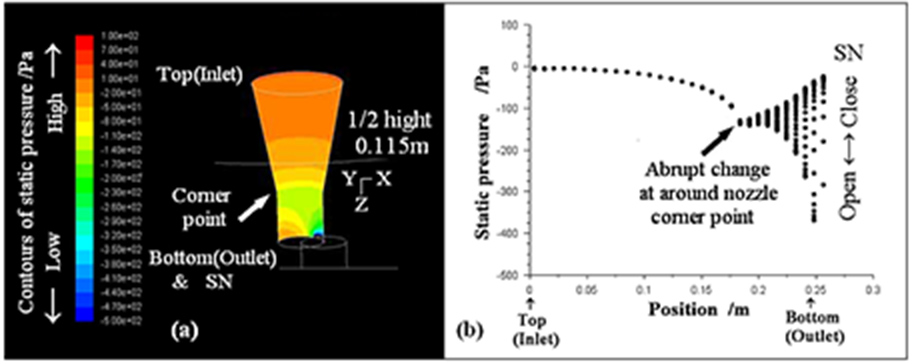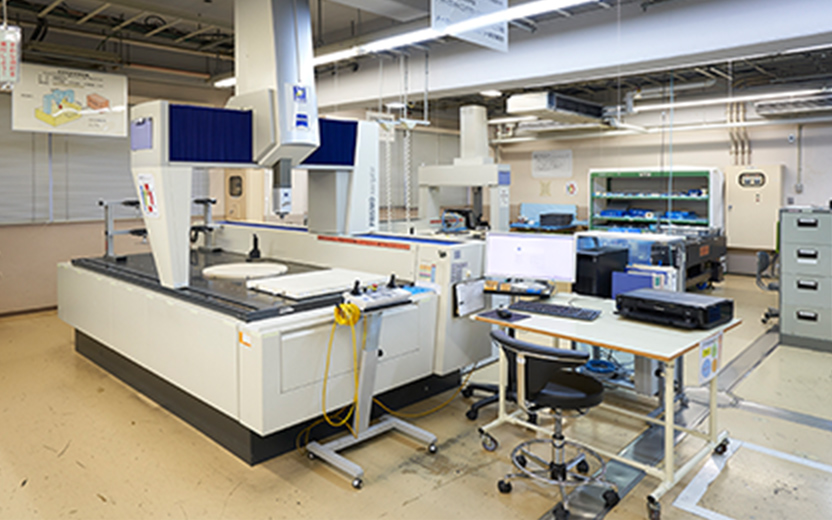2024/03/01
COMPANY
Research and Development
Krosaki Harima’s research and development activities support “iron and steel processes” for the production of high quality iron and steel.
Various kinds of refractory evaluation apparatus and highly accurate simulations, modeled on actual steelworks
From the manufacture of refractories to the point of usage by the customer, the “evaluation” process is vital.
- What kinds of reactions are occurring with refractories inside the furnace?
- How much heat is being applied?
- Is the gas being vented?
- What degree of dissolved loss is there?
At Krosaki Harima’s Research Center/Institute, we have various kinds of high temperature evaluation apparatuses that can not only measure the basic characteristics of refractories but also simulate at laboratory level the different phenomena that occur in an actual steelworks.
We also use computer simulations (thermal stress analysis, fluid analysis, calculation of phase diagrams) in our efforts to improve prediction accuracy.

Optimizing product processes to meet customer needs
The premise of our research activities is “the improvement of customer satisfaction”.
In addition to researching the required product characteristics, an important point is “research to enhance customer value,” which studies to what extent a product can be made into a high value product that matches the customer’s intended application.
We carry out prior evaluations within the manufacturing process, before products are delivered to our customers.
After that, we obtain feedback on the product from our customers, and then implement a cycle of research and improvement in the research labs.
By enabling the production of high quality products that will satisfy our customers, we contribute to the improvement of their work efficiency.
Research for the creation of refractories that can produce high quality steel, capable of withstanding harsh environments
The melting point of iron (Fe) is 1538℃, hotter than lava. We seek the kind of stability that can withstand such environments.
What is particularly required of refractories is a high level of both corrosion resistance and thermal shock resistance.
In order to fully demonstrate the capabilities of being able to resist cracking and melting, even in very severe conditions of over 1500℃, it is essential to have high purity raw materials.
At our Research Center/Institute, we carefully select the materials of refractories to be used in the manufacture of high grade steel, and we also intentionally combine different granularities, thereby achieving excellent refractories that can answer our customers’ needs.
In this way, we lay the foundations for the manufacture of highly reliable refractories to be used in the manufacture of high grade steel.
Why do so many other countries seek Japanese “high grade steel”?
If you think of the steel cans for beverages that are sold in vending machines, you will realize that the steel that we use in daily life is very thin and is often worked into very complex forms. In order to achieve these complex forms, it is vital to have the technological ability to remove any harmful impurities from the steel as much as possible.
The special characteristics of good quality steel are that it has excellent corrosion and rust resistance properties, and is very light and easy to process.
The manufacture of steel with many excellent properties is a technology that is unique to Japan, and the high demand for such steel from countries around the world may be said to be a succinct expression of Japanese technological prowess.
A cross-sectoral research system adopting both process development and element development approaches
Innovative technologies born out of knowledge interaction among researchers
Traditionally, at Krosaki Harima we have trained up specialists for each of the product groups “kiln refractories,” “functional refractories” and “unshaped refractories.”
In addition, we are currently restructuring the research organization in order to share the knowledge of each group and to link to the development of new technologies and products.
- Process and product development (product manufacture)
- Element development (product basic research)
We divide our research into these two broad categories, and for each of the product groups we conduct collaborative research in order to study various topics jointly. By having our researchers exchange knowledge and element technology in a cross-sectoral manner, we can achieve product development that further enhances customer value.
New technologies created from the perspective of the collaboration between industry and academia
We work with universities and related companies, focusing on research within an industry-academia collaboration. And, regarding the various kinds of phenomena that occur when refractories come into contact with slag and molten steel, we are conducting detailed analysis from many different perspectives, for example through the use of analysis equipment leveraging the latest technologies of universities and related companies.
Also, at Krosaki Harima we encourage people in-house to acquire Ph. D. and we will be further honing the technologies used in our refractories and ceramics in the future.

Message from the Research Center/Institute
Wherever you see a chimney, you’ll always find refractories.
Fire is one of mankind’s greatest tools. One of the key materials that allow us to handle fire is refractories, and it is from these refractories that fine ceramics are born.
Our technologies are in demand around the world, but the demand is not only for today’s excellent technologies, or for new technologies for the future.
The kinds of technologies that Japan needed in the past while it was still developing are now needed in places like India and Asia, and are supporting local infrastructure and manufacturing.
Refractories are incredibly fascinating materials that can withstand severe conditions with temperatures in excess of 1500℃, and provide fundamental support to the manufacturing industry and indeed practically everything in our daily lives.
And there are still a great many discoveries hidden within refractories.
Why not take advantage of this technological wave and be part of the work of refractory development, giving rein to your own strengths?